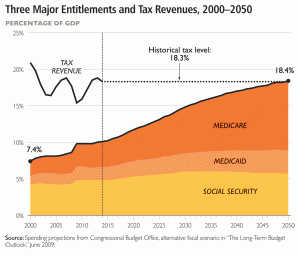We “rob from Peter to pay Paul.” The last post looked at Peter as a source in income, and now we will look at Paul and what we spend on him. It won’t take long. A quick look at the data makes it clear where cuts must occur, but the problem is making the cuts. We don’t pass a day in the news without hearing the Republicans wanting to cut $100B and the Democrats $33B from Discretionary Spending. Go back and look at the second chart in the first post. Non-Military Discretionary Spending is 13.5% of the total spending budget. Cut it all and the deficit problem is not solved.
Lets look closer at spending. The next two charts are taken from the Heritage Foundation report, “Federal Spending By The Numbers 2010.” The Foundation is a conservative organization, but their data is sourced from government agency reports.
Click the chart to enlarge. The top ten categories ending with Education make up 88% of the budget. Any discussion about spending cuts that will seriously reduce the Deficit must be in these ten categories. The rest is, as an acquaintance says, “mice nuts.”
I will get to Social Security, Medicare, and Medicaid next, but first consider National Defense. This is a discretionary category that remains untouched. One might ask if we need military stationed in Europe or Okinawa? Do we need new advanced aircraft carriers, submarines, nuclear missiles, or stealth fighters? It seems that future wars will be cyber or gorilla in nature, and it looks like we are enhancing a military for the past. No doubt there is room to cut, and no doubt it is politically painful. Remember, budget cuts always cost jobs and cash flow in someone’s neighborhood.
Moving on to the three big entitlements, the next chart shows the source of worry. Left to grow untouched, Entitlement spending will consume all federal income in the next forty years. There will not be one dollar available for any other category of spending.
What can I say? These still remain the “third rail” of politics — too dangerous to touch. But, it will happen, and the longer we wait, the worse it will be.
Social Security gets considerable political attention. It has both short and long term problems. Last year was the first since 1984 that its income was less than its expenses. Not a problem, SS has a very large trust fund, but most of it has been loaned to the government general fund. SS will have to start calling its IOUs, and this is the short term problem for the federal deficit. The longer issue is that the trust fund reaches zero in 2037. Then benefits will have to be reduced as much as 22% to balance the SS budget. The solution rest in increasing the tax base, lowering cost of living increases, and extending retirement age. These are easy fixes compared to Medicare finances, which I have not taken time to understand.
So you see the problem, borrow more, tax more, and/or spend less. Borrowing more is becoming less acceptable. The public is getting wise, and the cost of borrowing is increasing. Increased taxing is still too tied to political ideology. Spending cuts, well we have not yet answered the reality issue. Is continued spending growth in Military, SS, Medicare, and Medicaid preparing the country for future economic competitiveness or dragging it down? I will wrap up this study in one concluding post.
[print_link]



Leave a Reply